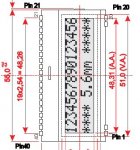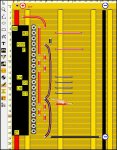marcos.placona
Senior Member
Hi, some people might have seen my post today about the seven segment displays. In fact, I decided to take the advices and move from it to a LCD display. The display I've got are the Dog Displays from MMS (http://www.mmselectronics.co.uk/lcddog.htm)
I know it should use just 4 wires to have the whole connection, but I can't really understand how to wire it up.
This is the display:

As you can see, it has 20 pins on the top, and four (two on each side) on the bottom.
I understand that I need to have those 4 pins on the bottom connected, as I'm not using any backlight, but have no idea about which pin is which on the top.
I got this from the datasheet, but honestly I didn't understand. Bear with me, I'm just a starter on this whole thing:

I'm not asking for anyone to do the job for me, I just want to have some guidance about where to go. I've read the manual about 10 times now to see if I could get something, but things don't make sense at all for me.
I have no idea about what those pins mean, so I don't know how to start to code this thing. I just wanted to display something like a "hello world", and would go from that to my application, but the way it stands now, I think I don't even know how to display it.
I've been doing reseacrh on it the whole day, but can't get anything working.
I even found this example by MELAZARUS (http://i15.tinypic.com/2uqeiic.jpg), and tried to wire it up the same way, but simply nothing happens.
Can someone please help me?
Thanks in advance,
I know it should use just 4 wires to have the whole connection, but I can't really understand how to wire it up.
This is the display:

As you can see, it has 20 pins on the top, and four (two on each side) on the bottom.
I understand that I need to have those 4 pins on the bottom connected, as I'm not using any backlight, but have no idea about which pin is which on the top.
I got this from the datasheet, but honestly I didn't understand. Bear with me, I'm just a starter on this whole thing:

I'm not asking for anyone to do the job for me, I just want to have some guidance about where to go. I've read the manual about 10 times now to see if I could get something, but things don't make sense at all for me.
I have no idea about what those pins mean, so I don't know how to start to code this thing. I just wanted to display something like a "hello world", and would go from that to my application, but the way it stands now, I think I don't even know how to display it.
I've been doing reseacrh on it the whole day, but can't get anything working.
I even found this example by MELAZARUS (http://i15.tinypic.com/2uqeiic.jpg), and tried to wire it up the same way, but simply nothing happens.
Can someone please help me?
Thanks in advance,








